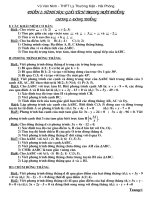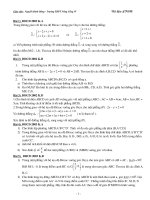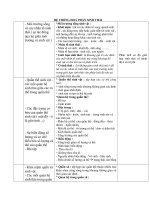Reading 12 Ôn thi CFA
Bạn đang xem bản rút gọn của tài liệu. Xem và tải ngay bản đầy đủ của tài liệu tại đây (263.14 KB, 5 trang )
PRACTICE PROBLEMS
1 As the reserve requirement increases, the money multiplier:
Aincreases.
Bdecreases.
C remains the same.
2 Which is the most accurate statement regarding the demand for money?
A Precautionary money demand is directly related to GDP.
B Transactions money demand is inversely related to returns on bonds.
C Speculative demand is inversely related to the perceived risk of other assets.
3 The following exhibit shows the supply and demand for money:
MS
MD
Nominal rate of interest
336
© CFA Institute. For candidate use only. Not for distribution.
Reading 12 ■ Monetary and Fiscal Policy
I1
I0
I2
M1
M0
M2
Quantity of money
There is an excess supply of money when the nominal rate of interest is:
A I0.
B I1.
C I2.
4 According to the theory of money neutrality, money supply growth does not
affect variables such as real output and employment in:
A the long run.
B the short run.
C the long and short run.
5 Which of the following best describes a fundamental assumption when monetary policy is used to influence the economy?
A Financial markets are efficient.
B Money is not neutral in the short run.
C Official rates do not affect exchange rates.
6 Monetarists are most likely to believe:
A there is a causal relationship running from inflation to money.
B inflation can be affected by changing the money supply growth rate.
© 2011 CFA Institute. All rights reserved.
Practice Problems
© CFA Institute. For candidate use only. Not for distribution.
C rapid financial innovation in the market increases the effectiveness of monetary policy.
7 The proposition that the real interest rate is relatively stable is most closely
associated with:
A the Fisher effect.
B money neutrality.
C the quantity theory of money.
8 Which of the following equations is a consequence of the Fisher effect?
A Nominal interest rate = Real interest rate + Expected rate of inflation.
B Real interest rate = Nominal interest rate + Expected rate of inflation.
C Nominal interest rate = Real interest rate + Market risk premium.
9 Central banks would typically be most concerned with costs of:
A low levels of inflation that are anticipated.
B moderate levels of inflation that are anticipated.
C moderate levels of inflation that are not anticipated.
10 Monetary policy is least likely to include:
A setting an inflation rate target.
B changing an official interest rate.
C enacting a transfer payment program.
11 Which role is a central bank least likely to assume?
A Lender of last resort.
B Sole supervisor of banks.
C Supplier of the currency.
12 Which is the most accurate statement regarding central banks and monetary
policy?
A Central bank activities are typically intended to maintain price stability.
B Monetary policies work through the economy via four independent
channels.
C Commercial and interbank interest rates move inversely to official interest
rates.
13 When a central bank announces a decrease in its official policy rate, the desired
impact is an increase in:
Ainvestment.
B interbank borrowing rates.
C the national currency’s value in exchange for other currencies.
14 Which action is a central bank least likely to take if it wants to encourage businesses and households to borrow for investment and consumption purposes?
A Sell long-dated government securities.
B Purchase long-dated government treasuries.
C Purchase mortgage bonds or other securities.
15 A central bank that decides the desired levels of interest rates and inflation and
the horizon over which the inflation objective is to be achieved is most accurately described as being:
A target independent and operationally independent.
B target independent but not operationally independent.
337
338
© CFA Institute. For candidate use only. Not for distribution.
Reading 12 ■ Monetary and Fiscal Policy
C operationally independent but not target independent.
16 A country that maintains a target exchange rate is most likely to have which
outcome when its inflation rate rises above the level of the inflation rate in the
target country?
A An increase in short-term interest rates.
B An increase in the domestic money supply.
C An increase in its foreign currency reserves.
17 A central bank’s repeated open market purchases of government bonds:
A decreases the money supply.
B is prohibited in most countries.
C is consistent with an expansionary monetary policy.
18 In theory, setting the policy rate equal to the neutral interest rate should
promote:
A stable inflation.
B balanced budgets.
C greater employment.
19 A prolonged period of an official interest rate very close to zero without an
increase in economic growth most likely suggests:
A quantitative easing must be limited to be successful.
B there may be limits to the effectiveness of monetary policy.
C targeting reserve levels is more important than targeting interest rates.
20 Raising the reserve requirement is most likely an example of which type of monetary policy?
ANeutral.
BExpansionary.
CContractionary.
21 Which of the following is a limitation on the ability of central banks to stimulate growth in periods of deflation?
A Ricardian equivalence.
B The interaction of monetary and fiscal policy.
C The fact that interest rates cannot fall significantly below zero.
22The least likely limitation to the effectiveness of monetary policy is that central
banks cannot:
A accurately determine the neutral rate of interest.
B regulate the willingness of financial institutions to lend.
C control amounts that economic agents deposit into banks.
23 Which of the following is the most likely example of a tool of fiscal policy?
A Public financing of a power plant.
B Regulation of the payment system.
C Central bank’s purchase of government bonds.
24The least likely goal of a government’s fiscal policy is to:
A redistribute income and wealth.
B influence aggregate national output.
C ensure the stability of the purchasing power of its currency.
Practice Problems
© CFA Institute. For candidate use only. Not for distribution.
25 Given an independent central bank, monetary policy actions are more likely
than fiscal policy actions to be:
A implementable quickly.
B effective when a specific group is targeted.
C effective when combating a deflationary economy.
26 Which statement regarding fiscal policy is most accurate?
A To raise business capital spending, personal income taxes should be
reduced.
B Cyclically adjusted budget deficits are appropriate indicators of fiscal policy.
C An increase in the budget surplus is associated with expansionary fiscal
policy.
27The least likely explanation for why fiscal policy cannot stabilize aggregate
demand completely is that:
A private sector behavior changes over time.
B policy changes are implemented very quickly.
C fiscal policy focuses more on inflation than on unemployment.
28 Which of the following best represents a contractionary fiscal policy?
A Public spending on a high-speed railway.
B A temporary suspension of payroll taxes.
C A freeze in discretionary government spending.
29 A “pay-as-you-go” rule, which requires that any tax cut or increase in entitlement spending be offset by an increase in other taxes or reduction in other
entitlement spending, is an example of which fiscal policy stance?
ANeutral.
BExpansionary.
CContractionary.
30 Quantitative easing, the purchase of government or private securities by the
central banks from individuals and/or institutions, is an example of which monetary policy stance?
ANeutral.
BExpansionary.
CContractionary.
31The most likely argument against high national debt levels is that:
A the debt is owed internally to fellow citizens.
B they create disincentives for economic activity.
C they may finance investment in physical and human capital.
32 Which statement regarding fiscal deficits is most accurate?
A Higher government spending may lead to higher interest rates and lower
private sector investing.
B Central bank actions that grow the money supply to address deflationary
conditions decrease fiscal deficits.
C According to the Ricardian equivalence, deficits have a multiplicative effect
on consumer spending.
33 Which policy alternative is most likely to be effective for growing both the public and private sectors?
A Easy fiscal/easy monetary policy.
339
340
© CFA Institute. For candidate use only. Not for distribution.
Reading 12 ■ Monetary and Fiscal Policy
B Easy fiscal/tight monetary policy.
C Tight fiscal/tight monetary policy.









